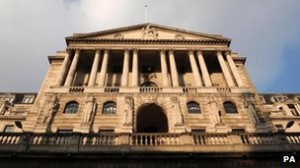Bank of England refrains from further QE stimulus
13 January 2013

The Bank of England has decided not to extend its quantitative easing (QE) stimulus programme, which has injected £375bn into the UK financial system.
It is also keeping its key interest rate unchanged at 0.5%, where it has been since March 2009.
Under QE, the Bank creates money and uses it to buy government bonds to try to stimulate the economy.
It has previously warned economic output could contract for the last three months of 2012.
That would raise the prospect of a triple-dip recession.
Official figures for fourth quarter gross domestic product (GDP) are due to be released on 25 January.
‘Mixed signals’
The minutes from this meeting of the rate-setting monetary policy committee (MPC) will be released two days before that.
“A change in monetary policy was unlikely this month, given the UK economy continues to send out mixed signals,” said Anna Leach, from employers’ organisation the CBI.
She added that there were signs of some stimulus coming from a separate scheme.
“Underlying economic conditions remain fairly flat and there are early signs that credit availability is being boosted by the Funding for Lending Scheme (FLS).”
FLS involves the Bank of England offering up to £60bn in cheap loans to banks and building societies, with the aim that this money should then be lent to individuals and companies to help stimulate the economy.
“There are early signs that this scheme is starting to bear fruit,” agreed Joost Beaumont at ABN Amro.
“Meanwhile, global economic conditions seem to be improving, while risks emanating from the euro crisis have diminished.”
Some analysts are predicting that there will be another £50bn of QE in the first half of 2013, but the British Chambers of Commerce has said that would be a mistake.
“Adding to QE should only be considered if new threats emerge to the stability of the UK banking system,” said its chief economist David Kern.
“We believe that further QE would provide only marginal benefits for the real economy, while heightening longer-term risks of financial distortions, bubbles and higher inflation.”

Recent Comments